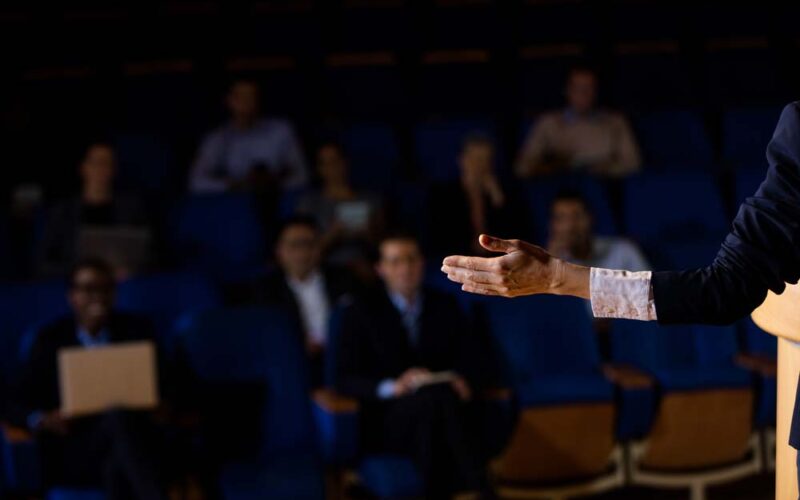Introduction
Leadership is a fundamental virtue that a leader should have for team integration, business success, and achieving organisational objectives. This report is to study the role of leadership and its importance by applying related academic theories to Apple and its chief executive officer (CEO), Tim Cook. The first section of the report will explore the background information of Apple and Tim Cook, and the theoretical application will be covered in the following section. Then, a recommendation will be made at the end of the report.
2.0 Apple and Tim Cook
This section will cover Apple and Tim Cook’s background information, Apple’s organisational goals and challenges, and the leadership and role of Tim Cook as a CEO before addressing the academic theories of leadership in the next section.
2.1 Background information of Apple and Tim Cook
Apple is one of the world most influential multinational high-tech companies headquartered in Cupertino, California, and was founded in 1976 by Steve Jobs, Ronald Wayne, and Steve Wozniak (O’Grady, 2009). The current chief executive officer (CEO) of the company is Tim Cook. He was born in 1960 in the U.S. and earned MBA from Duke University in 1988.
Before joining Apple in 1998, He worked for IBM for 12 years and became a North American director with outstanding performance. Later, he became a chief operating officer (COO) at Intelligent Electronics and moved to Compaq Computer Corporation, where he served as vice president of corporate materials. Then, He served as a COO before being named CEO of Apple in 2011 (Apple, 2021; Kahney, 2019). All his experiences as a director, COO, and the vice president laid the foundation for many of the factors he should have as CEO.
Apple is selected for this report because it is expected that the leadership skills of Tim Cook can be gleaned while studying the case of Apple addressing the social challenge under his leadership.
2.2 Organisational goals of Apple and Challenges
Apple’s mission is “to bring the best personal computing products and support to students, educators, designers, scientists, engineers, businesspersons and consumers in over 140 countries around the world” (Apple, 2000), and ‘to make the best products on earth and to leave the world better than we found it’ (Cook, 2021). These show that Apple is trying to be socially and environmentally responsible while keeping its profitability. Apple has six core values to fully deliver its mission: Accessibility, Education, Environment, Inclusion and Diversity, Privacy, Racial Equity and Justice, and Supplier Responsibility.
Apple’s challenge, which will be addressed in this report, concerns privacy among six core values. In 2016, the U.S government and Federal Bureau of Investigation (FBI) demanded Apple to help in unlocking the iPhone of a terrorist and build a “backdoor” to the iPhone operating system (IOS), so that FBI agents can unlock the phone and access the information to investigate the networks of terrorists, activities, and to get crucial insights into the motives of the attack (Jacobson, 2017; Kountze, 2018). However, it was completely opposed to Apple’s privacy policy as there are risks of customers’ personal information being accessed by a third party without consent (Cook, 2016). As CEO of Apple, Tim Cook was obliged to resolve this ethical dilemma between the two ‘rights’ wisely.
2.3 Tim Cook’s leadership and his role
The values and norms a leader follow have a significant impact on the organisational culture and policies (Schein, 2017). Ohio University (2020) defined the leadership of Tim Cook as transparency, teamwork, high-expectations, and calm demeanour. Also, Kim (2020) argued that Tim Cook is a transformational leader as he presents a compelling vision to employees to adjust new system. Transparency, one of Tim Cook’s leadership values, is also seen in Apple’s customer privacy policy. According to Apple (2021), a transparency report is published twice a year to transparently disclose government requests for customer data and Apple’s response to it to customers.
Generally, the role of leaders is to motivate, manage, inspire, and remunerate to increase corporate performance and productivity (Hurduzeu, 2015). As a CEO and leader of an organisation, the role of Tim Cook is to be the centre of communication between the board of directors and corporate operations, make crucial corporate decisions, manage overall resources and operations, and identify and engage people to achieve the organisational objective of Apple (Decker, 2016). Tim Cook’s leadership analysis based on academic theory will be covered in the following section.
3.0 Application to Academic Theories
Leadership can be defined as ‘a process whereby an individual influences a group of individuals to achieve a common goal’ (Northouse, 2019, p. 30). Leadership is essential to complement the organisation’s system and to increase the motivation and satisfaction of followers. Leadership is also crucial at a strategic level, requiring it to ensure coordinated functionality as organisations interact with a dynamic external environment (Antonaks & Day, 2018).
In this section, the concept of leadership theories and different styles of leadership, responsible leadership and leadership skills, and ethical decision-making approaches will be covered. Then, the theories and approaches will be applied to the case of Apple’s social challenge to identify how Tim Cook addressed the challenge.
3.1 Leadership theories and leadership styles
Among many approaches to leadership, the behavioural theory and the situational theory will be covered in this section. Behavioural theory is the approach that the behaviour of the leader is emphasised. What and how the leaders do is the main focus of this approach. According to the behavioural approach, there are two types of behaviours of leaders: task behaviours and relationship behaviours. Task behaviours help in achieving the organisational objectives and facilitate goal accomplishment whereas relational behaviours help subordinates feel comfortable with the working environment. To achieve their organisational objectives, leaders must combine these two types of behaviours appropriately (Northouse, 2019).
Figure 1 Leadership Grid
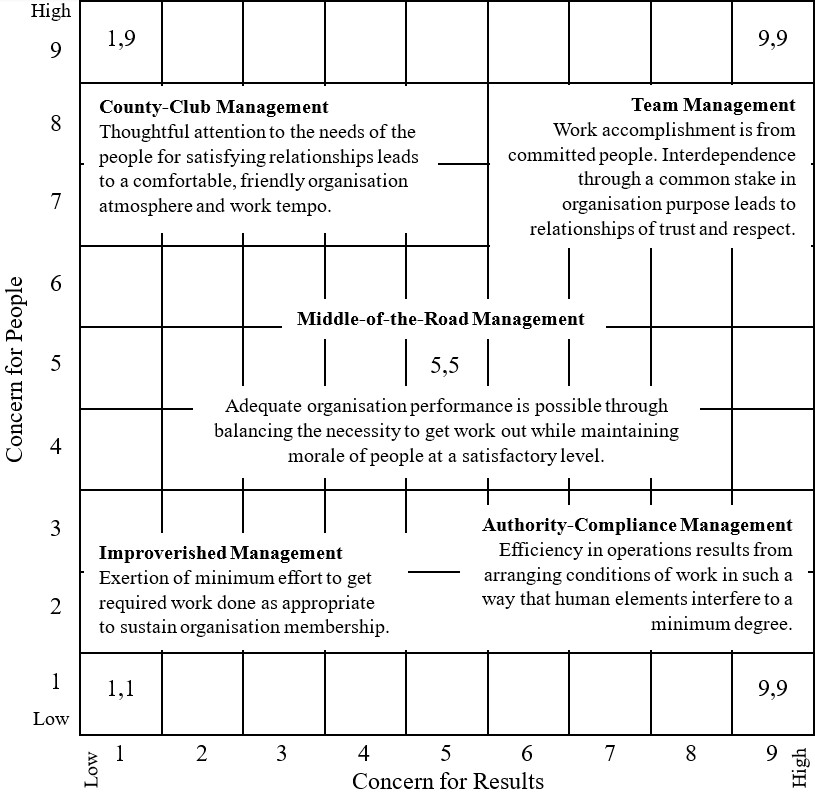
Source. From Leadership Dilemmas: Grid Solutions (p. 29), by R. R. Blake & A. A. McCanse, 1991, Gulf Pub. Co. Copyright 1991 by Scientific Methods, Inc.
The Leadership Grid® is a model derived from the behavioural approach that is used for organisational leadership training and development. It explains how leaders can help achieve their objectives through two factors: concern for production and concern for people (concern for production and concern for people are the same as task behaviours and relationship behaviours). Concern for production is how leaders are concerned with achieving their organisational tasks. On the other hand, concern for people refers to how leaders care about people who are endeavouring to achieve their organisational goals (Northouse, 2019). The level of concern for production and concern for people are measured in the Leadership Grid®. See Figure 1.
As shown in Figure 1, five leadership styles are derived from the Leadership Grid according to the degree of task behaviours and relationship behaviours of the leader: County-Club Management, Team Management, Middle-of-the-Road Management, Impoverished Management, and Authority-Compliance Management. The detailed descriptions of each leadership style are contained in Table 1.
Table 1 Descriptions of Behavioural Leadership Styles
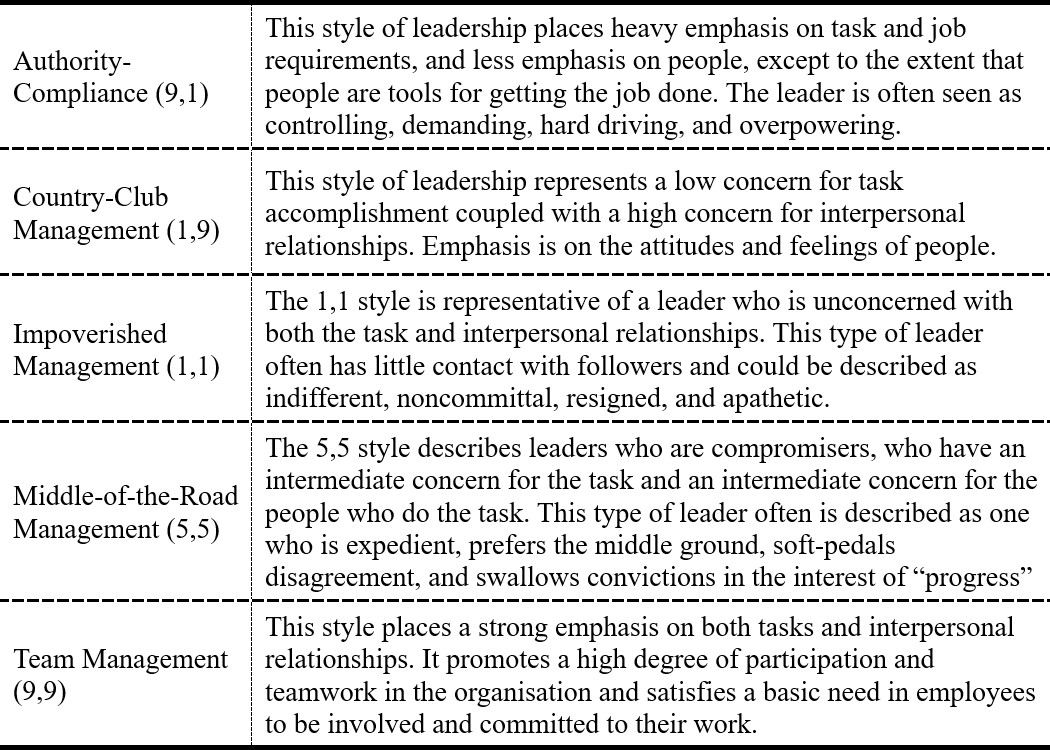
The behavioural leadership approach provides a framework for broad evaluation of leadership as behaviour with a task and relationship dimensions. However, different leadership styles may be required depending on the situation. Therefore, the behavioural approach is not an absolute leadership theory (Northouse, 2019).
The leadership theory that complements the behavioural approach is the situational theory. Situational approach is one of the most recognised approaches to leadership which is extensively used in training and development of organisational leadership (Northouse, 2019). This approach focuses on leadership in situations and presupposes that different leadership styles are needed depending on the situation. In this respect, effective leaders should be able to adjust their styles to the needs of different situations (Schermerhorn, 1997).
According do Hersey and Blanchard (1988), “situational leadership is based on an interplay among (1) the amount of guidance and direction (task behaviour) a leader gives, (2) the amount of socioemotional support (relationship behaviour) a leader provide, and (3) the readiness level that followers exhibit in performing a specific task, function or objective” (p.170). These are the factors that distinguish leadership styles of a leader in different situations. Figure 2 shows the situational leadership model.
Figure 2 Situational Leadership Model
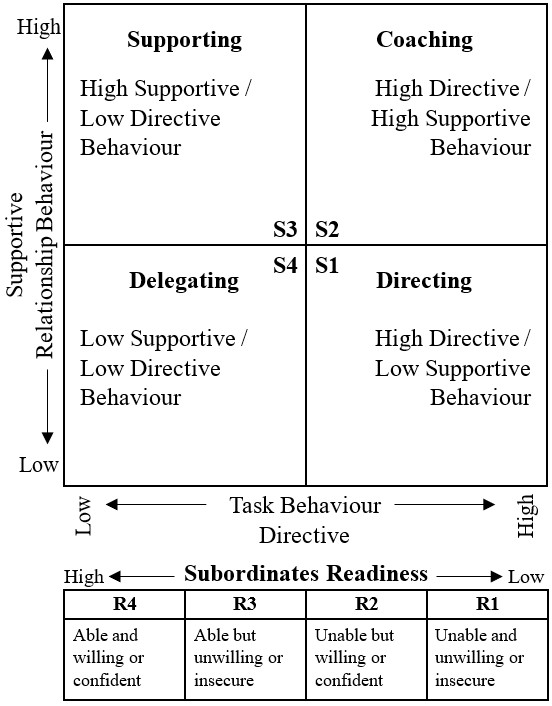
As shown in Figure 2, there are four styles of leadership: directing, coaching, supporting, and delegating. The most important situational factor in determining leadership style is the subordinates’ task-related readiness. The most effective combinations of leadership style and readiness of subordinates are as follows: (a) Directing style for R1, (b) Coaching style for R2, (c) Supporting style for R3, and (d) Delegating style for R4 (Goodson et al., 1989). Table 2 contains the descriptions of each leadership style.
Table 2 Descriptions of Situational Leadership Styles
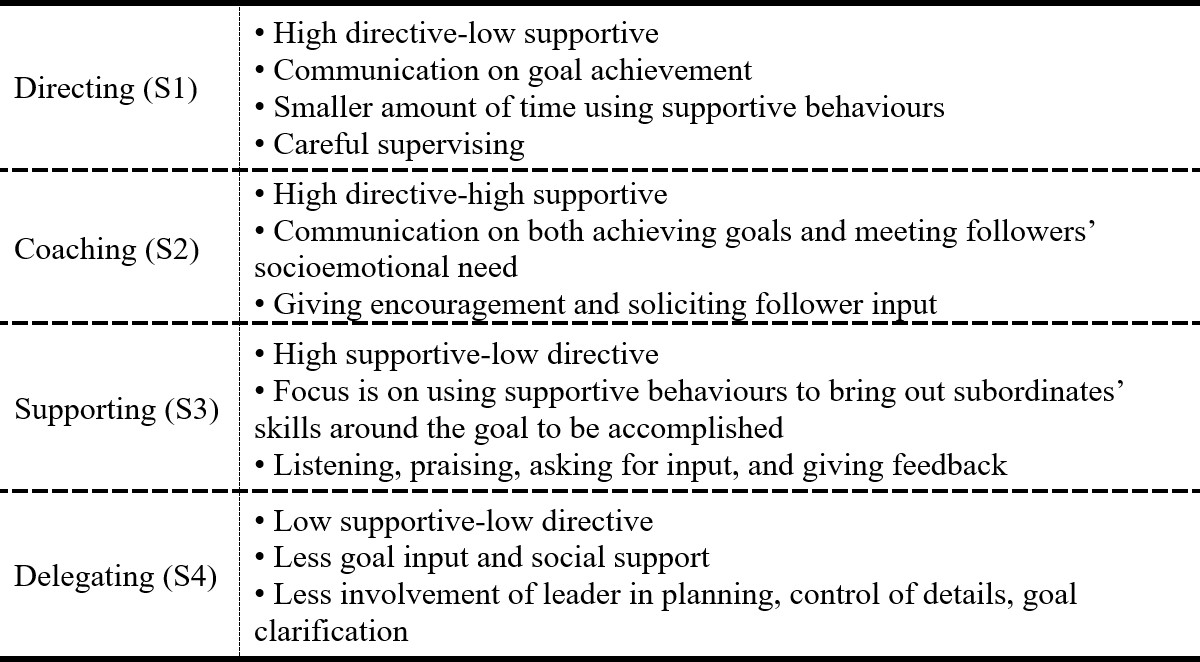
Various leadership styles are identified through behavioural and situational theories. Using behavioural theory (Leadership Grid), the leadership style of Tim Cook is identified. As it is described earlier, Cook’s leadership is high-expectations and teamwork. According to Kahney (2019), Cook endeavours “to create a sense of company camaraderie” (p. 13), and values people in the organisation, hard-working to achieve success, and working as a team. Therefore, his leadership can be defined as Team Management (9,9) style. Situational approach will be used in the Part 3.3.
3.2 Ethical approaches to decision-making
The decision-making process is critical to any organisation or business, and ethics has a significant impact on it. Ethical issues are either explicitly or implicitly involved in any decision-making process. Ethics has to do with the leader’s values and morals and his/her nature of behaviour and virtuousness (Northouse, 2019). In this part, three different ethical decision-making approaches that provide a system of principles that helps make decisions about what is right and wrong in a particular situation: ethical egoism, altruism, and utilitarianism.
Egoism is a concept that an individual must be the beneficiary of his/her code of morals and his/her actions (Avolio & Locke, 2002). Self-interest may be the ethical stance of a leader who has this orientation. On the contrary, altruism, also called self-sacrifice, is a concept that the beneficiary of an individual’s actions or moral code must be other people or society (Avolio & Locke, 2002). A leader with this orientation would take others’ interests into account when making decisions (Bowie, 1991). The concept of utilitarianism states that an action that produces the greatest good and the least harm for the greatest number of people who are affected is morally correct (Schumann, 2001). Figure 3 represents three approaches based on the degree of concern for self-interest and concern for the interest of others.
Figure 3 Ethical Egoism, Utilitarianism, and Altruism
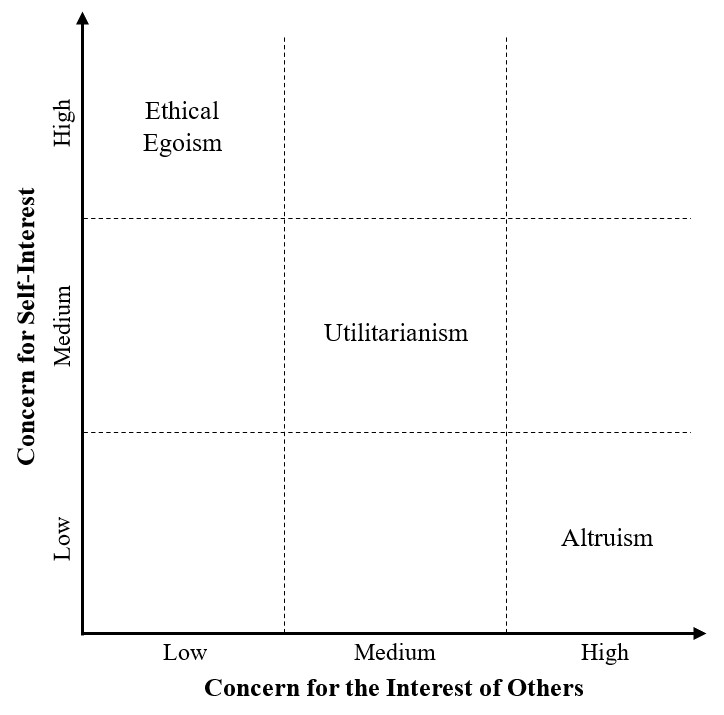
3.3 Application to the case of Apple and Tim Cook
This part will identify the leadership style and the decision-making approach that Tim Cook used in addressing the social challenge using the situational leadership theory and three ethical approaches. Before assessing the style of leadership and decision-making approach used, how the social challenge has been resolved will be addressed first.
As mentioned in Part 2.2, Team Cook had to decide whether to build a backdoor to the iPhone operating system so that FBI agents could access information of iPhone users or reject the request from the government and the FBI to protect users’ privacy. He decided to protect the customers’ personal information by not building a backdoor to the system as it may be a significant threat to data security. However, he did provide other data that was in Apple’s possession and engineers and ideas on a number of investigative options to support the FBI (Cook, 2016).
In the process of addressing the social challenge, Tim Cook used the directive leadership style. As this social challenge was closely related to customers’ personal information and the national security of the U.S, the impact that the decision would have on society and the company was significant. Hence, the decision was not something that any employees could make upon their opinion, which means that the readiness of the employees was low (R1: unable and unwilling or insecure). Therefore, Tim Cook, as a CEO and leader of Apple, used the directive style in the situation where a social issue that might bring a significant impact should be addressed.
In regard to the decision-making approach, Tim Cook took a utilitarian approach when addressing the issue as his decision was for the greatest good of society, and produced the least harm (Kountze, 2018; Mill, 2016). According to Kountze (2018), his decision best served the Apple brand, its customers, and shareholders. The company could avoid spending money and time to build the backdoor and satisfy customers who thought privacy was a critical factor in choosing iPhones. As Cook’s decision was for creating the least harm while producing the greatest good for the greatest number of people in society and for the company, it can be concluded that the utilitarian approach was the one that Cook has taken.
4.0 Recommendation
The directive leadership style that Tim Cook used was effective because privacy and personal information are sensitive factors that employees cannot decide what to do with them recklessly. His leadership style complemented the low readiness of employees and, as a result, brought a better brand value, and benefited the customers and shareholders.
If Cook decided to provide a backdoor to the FBI, the FBI might have found the information to help the investigation and comforted the victims’ families. In addition, it may have helped future investigations as well as prevented future terrorist attacks. However, directive style would have been used in this case as well.
5.0 Conclusion
Through this report, Tim Cook’s leadership style was identified using situational and behavioural theories. Cook’s leadership style based on the behavioural theory is team management style. And it was found that he used the directive style and utilitarian approach when addressing the social challenge of Apple. If Apple’s strong customer privacy policy continues to be developed and maintained, it could attract more customers and brighten the company’s future prospects.
Reference List
Antonakis, J., & Day, D. V. (2018). Leadership: Past, Present, and Future. In J. Antonakis & D. V. Day (Eds.), The Nature of Leadership (pp. 3-26). Sage Publications. https://doi.org/10.4135/9781506395029.n1
Apple. (2000). Apple and EarthLink Form Partnership to Deliver Best ISP Service to Macintosh Users. Apple Newsroom. https://www.apple.com/newsroom/2000/01/05Apple-and-EarthLink-Form-Partnership-to-Deliver-Best-ISP-Service-to-Macintosh-Users/
Apple. (2021a). Apple Leadership – Tim Cook. https://www.apple.com/uk/leadership/tim-cook/
Apple. (2021b). Privacy – Transparency Report. https://www.apple.com/legal/transparency/
Avolio, B. J., & Locke, E. E. (n.d.). Contrasting Different Philosophies of Leader Motivation: Altruism Versus Egoism. The Leadership Quarterly, 13, 169–191.
Blake, R. R., & McCanse, A. A. (1991). Leadership Dilemmas: Grid Solutions. Gulf Pub. Co.
Bowie, N. E. (1991). Challenging the Egoistic Paradigm. Business Ethics Quarterly, 1(1), 1–21.
Cook, T. (2016). A Message to Our Customers. Apple. https://www.apple.com/customer-letter/
Cook, T. (2021). Apple – Environment Social Governance. Apple. https://investor.apple.com/esg/default.aspx
Decker, J. C. (2016). CEO: Mastering the Corporate Pyramid. Praeger.
Goodson, J. R., McGee, G. W., & Cashman, J. F. (1989). Situational Leadership Theory: A Test of Leadership Prescriptions. Group & Organization Studies, 14(4), 446–461. https://doi.org/10.1177/105960118901400406
Hersey, P., & Blanchard, K. H. (1988). Management of Organizational Behaviour: Utilizing Human Resources (5th ed.). Prentice-Hall.
Hurduzeu, R.-E. (2015). The Impact of Leadership on Organizational Performance. SEA-Practical Application of Science, 3(1), 289–293.
Jacobson, D. (2017). Building a “Backdoor” to the Iphone: An Ethical Dilemma. Ivey Publishing, 1–10.
Kahney, L. (2019). Tim Cook: The Genius Who Took Apple to the Next Level. Portfolio Penguin.
Kim, H. (2020). Comparison of Strategic Leadership: Steve Jobs and Tim Cook. Business and Management Studies, 6(3), 17–25. https://doi.org/10.11114/bms.v6i3.5010
Kountze, M. (2018). Building A Backdoor to the iPhone: What Dilemmas Did Tim Cook Face? 1–11. https://doi.org/10.13140/RG.2.2.22149.04329
Mill, J. S. (2016). Utilitarian View on Government Personal Technology Access. Liberrimus. https://sites.dwrl.utexas.edu/liberrimus/2016/10/10/utilitarian-view-on-government-personal-technology-access/
Northouse, P. (2019). Leadership: Theory and Practice (8th ed.). Sage.
O’grady, J. D. (2009). Apple Inc. Greenwood Press.
Ohio University. (2018). How Apple’s Leadership Changed. https://onlinemasters.ohio.edu/blog/apple-leadership-infographic/
Schein, E. H. (2017). Organizational Culture and Leadership. Wiley.
Schermerhorn, J. R. (1997). Situational Leadership: Conversations with Paul Hersey. Mid-American Journal of Business, 12(2), 5–11.
Schumann, P. L. (2001). A Moral Principles Framework for Human Resource Management Ethics. Human Resource Management Review, 11(1-2), 93–111. https://doi.org/10.1016/s1053-4822(00)00042-5
